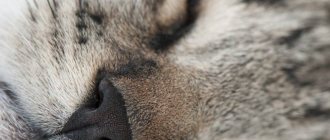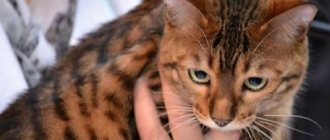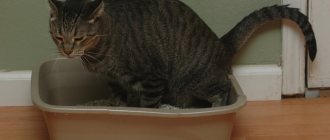The cat is a natural hunter with great agility to pursue its prey. Primarily, their keen sense of smell helps them track down prey. Their sense of smell is not only useful for hunting, but also helps them learn as much as possible about their environment. With such usefulness, anything that can harm their sense of smell can compromise the cat's overall well-being. Swelling or inflammation is one of the most obvious signs of a problem with your cat.
We study what happens when your cat's nose becomes swollen. It is imperative that you recognize this symptom as abnormal and requiring immediate veterinary attention. If this does not happen, the threat to their health may be much more serious than the loss of their ability to smell.
Symptoms Associated with a Swollen Nose in a Cat
As with any cat disease, we need to consider the context in which the cat's nose is swollen. This is especially true when we don't know the source of the problem. By looking at any other possible symptoms, we can better determine the underlying cause of the inflammation and help our veterinarian determine the best treatment option. These symptoms include:
© shutterstock
- Facial deformity (cat with a swollen face)
- Nasal or eye discharge
- Tearing
- Conjunctivitis
- Nasal congestion
- Cough
- Sneezing
- Breath sounds
- Loss of appetite
- Heat
- Apathy
- Bloody issues
Although we may not be able to diagnose the problem ourselves, providing as much information as possible helps to make an accurate diagnosis as soon as possible. This means examining behavioral changes as well as any physical symptoms that may occur.
Cat's nose is swollen due to foreign bodies
A foreign body lodged in a cat's nasal passage is one of the most common causes of nasal swelling. Cats love to explore and smell everything. Just like their reputation, a cat's curiosity can get them into trouble. They may collide face-to-face with or inhale something that will cause them significant damage. A foreign object can vary in size, but anything stuck in your sinuses is no good. Some of the most common objects that get stuck in a cat's nose include:
- Seeds
- Spikes
- Pieces of plastic
- Insects
- Sand/dirt
We may first be alerted to a dog's swollen nose when he sneezes, which is most likely to happen when a foreign body becomes lodged in the nose. The problem may also be accompanied by mucus discharge. We will need to look at the upper respiratory tract to see if there is anything there. However, we must try invasive methods that may cause additional harm.
Cat's nose swollen from insect bites
While this can happen to any cat, those that have an outlet are more likely to be bitten by bugs, parasites, or other bugs. This is because many of these creatures live outdoors. Insects and arachnids that can bite or sting your cat's nose and cause swelling include:
- Wasp
- Bee
- Scorpion
- Mosquito
- Bug
- Spider
The cause of swelling is related to the cat's immune response. Once the tissue detects the presence of a pathogen, the cat's immune response sends antibodies to where it is, and inflammation occurs as they fight it.
Parasites such as ticks and fleas also cause swelling on a cat's nose. They are not as likely here as they prefer other parts of the body. In these cases, in addition to swelling, you will likely see your cat trying to scratch its nose to relieve the itching.
Likewise, exposure to certain plants that are toxic to cats can cause inflammation. If the swelling is a reaction to a toxic substance, it will likely be accompanied by redness, sneezing and scratching, among other symptoms.
Rinsing the nasal passages
If a pet cannot breathe normally, this may be due either to the fact that its nose is clogged with dried exudate, or due to swelling and swelling of the mucous membranes. In all these cases, we recommend rinsing the animal’s nose, as this contributes to its speedy recovery. The procedure is not without pitfalls, and therefore we recommend enlisting someone’s help. Rinsing a cat's nose is done as follows:
- The solutions used for washing must be heated to a temperature of approximately 37°C.
- Ideally, you should use the smallest syringe for flushing, but an insulin syringe works well for this purpose. We recommend connecting a tube from a catheter for intravenous injections to its spout. It is thin enough to be inserted into the animal's nostrils.
- After this, the pet must be carefully secured in a lying position. If for some reason you were unable to get an assistant, you can press the cat’s head between your knees.
- When the cat is securely secured, they begin to inject the rinsing solution first into one nostril, then into the other. You can fill no more than 0.5 ml at a time. After each serving, it is necessary to pause so that the pet has time to rest properly.
- At the end of the procedure, it is necessary, using a gauze pad soaked in warm saline, to clean the cat’s face from any remaining washing liquid and exudate.
Since the animal will probably not be in the best mood after rinsing the nose, medicinal drops or other medications must be instilled/applied immediately, without letting the pet go! Otherwise, there is no guarantee that he will be caught.
Solutions used for rinsing the nasal cavity
In most cases, ordinary saline solution can be used for rinsing. But it is still better to treat the nasal cavity with a 0.05% chlorhexidine solution. It is not much more expensive than saline solution, but it has anti-inflammatory and antibacterial effects.
You may be interested in: Redness and swelling with lymphostasis
In addition, when treating rhinitis and, accordingly, nasal congestion, there is often a need to relieve swelling of the mucous membranes (as discussed above). For this purpose, you can use a 1-1.5% solution of ordinary table salt.
But! In order for rinsing to be effective and really help restore the cat’s former ease of breathing, it should be done regularly and as often as possible. So, for purulent rhinitis, it is recommended to rinse the animal’s nose every one and a half to two hours, until the symptoms completely disappear. If you carry out the procedure a couple of times a day, there will be no effect from it!
The cat's nose is swollen from allergies
Inflammation is one of the main symptoms of an allergic reaction in cats. The nose and face of a cat are no exception. Depending on the type of allergy, inflammation may spread to other areas. If the allergen is airborne, the cat's nose and mouth may initially become swollen when inhaled. This is similar to when a cat has a food allergy because the allergens come into contact with its mouth and face first.
As a rule, all types of allergies to cats are manifested by the following symptoms::
- Localized erythema (redness)
- Localized swelling/inflammation
- Itching
- Increased body temperature
- Sneezing
Although a swollen nose may not be serious, large amounts of the allergen can cause a more severe reaction. In these cases, the cat may develop anaphylactic shock. This is a severe and rapidly developing systemic allergic reaction. Symptoms of this reaction include:
- Swelling of the lips, tongue, face, neck and even the whole body
- Difficulty swallowing
- Dyspnea (difficulty breathing)
- Disease
- Vomit
- Abdominal pain
- Heat
- Death (if not treated promptly)
The severity of swelling and other symptoms depends on the time of exposure and the amount of allergens present. This is a veterinary emergency, so if you notice symptoms, take your animal to the veterinarian as soon as possible.
What to do?
Help for your pet is directly related to the cause that caused the swelling of the face. If swelling occurs due to traumatic injuries, the owner should immediately apply a cold compress to the area of injury. With its help it will be possible to relieve swelling and relieve pain. Then the owner needs to take the animal to a veterinary clinic, where an x-ray will be taken to confirm or rule out a possible jaw fracture.
Tumors that occur on the bridge of the nose, in the nose, on the cheeks, chin and other parts of the face begin to be treated after diagnostic measures are carried out. First of all, a biopsy is prescribed to show the nature of the neoplasm: malignant or benign. If a growth of the first type is diagnosed, surgery is mandatory.
An abscess is treated by opening it. If the situation is advanced and the purulent cavity is greatly enlarged, surgical intervention under general anesthesia may be required. After surgery, your pet will face a long and painful recovery period. Every day, the edges of the wound will need to be moved apart to clean the cavity of secretions and put the ointment prescribed by the veterinarian into it. Therapy for allergic reactions involves identifying the allergen and avoiding contact with it. Sometimes the animal may also be prescribed corticosteroids. However, medications from this group have a number of serious side effects, so they are used only in severe situations.
The cat's nose is swollen due to an abscess
When a cat has an abscess on its face, we see significant swelling. The mentioned swelling occurs due to the accumulation of pus. This phenomenon usually causes swelling of the face and nose in cats. An abscess may be a lump under the skin, but when it breaks through the skin, it can create a sore. The main causes of an abscess include:
- Dental problems : When the root of one or more teeth becomes infected, an abscess forms underneath, causing local swelling of the face. A very painful abscess can push upward and make it appear as if the nose itself is swollen.
- Trauma : A scratch or blow to the face is a fairly common cause of a swollen nose in your cat. This could happen if they hit something sharp, got scratched too much, or got into a fight with another animal. Bacteria entering the wound site can cause inflammation.
Treating abscesses in cats requires cleaning and disinfecting the wound. In more severe cases, treating the problem may require draining the abscess and using antibiotics.
© shutterstock
Feline cryptococcosis and swollen nose
Cryptococcosis in cats is caused by the fungi Cryptococcus neoformans or Cryptococcus gatti. These fungi are present in soil, bird droppings and some plants. They can be transmitted by inhalation. The result can be a pulmonary granuloma, a structure formed by inflammation due to various diseases. Immune cells known as macrophages attempt to cloak and wall off the agent or pathogen (in this case, a fungus) to prevent harm.
Cryptococcosis also affects dogs, ferrets, horses and humans. The condition is most often asymptomatic, meaning it does not show any observable symptoms. When clinical symptoms occur, they usually involve nasal problems, problems affecting the nervous system, skin problems, or other systemic reactions. Nasal symptoms are characterized by inflammation of the nasofacial area, which is accompanied by ulcers and nodules in this area.
Another very common symptom is a swollen cat's face, known as a " clown nose ." This is associated with characteristic swelling of the nose and inflammation of the sinuses. Other symptoms include sneezing, nasal discharge and swollen lymph nodes. Cats often have a runny nose and bloody discharge, especially when sneezing.
To accurately identify cryptococcosis in a cat, a biopsy and/or culture for the fungus is usually performed. The fungus can remain dormant for months or even years before symptoms appear, making it very difficult to determine its origin.
Lymphadenitis
When the lymph nodes (submandibular, axillary) are inflamed, the inflamed tissues swell greatly, the area of edema is very painful on palpation. When the submandibular lymph nodes are inflamed, the animal cannot chew (the process is very painful).
Swelling after sterilization
Postoperative swelling is not uncommon. Swelling and redness may be observed in the scar area. This occurs due to swelling of the internal sutures. No treatment is required; after the internal sutures are absorbed, this swelling goes away on its own.
Viral infections nasal swelling in cats
Feline AIDS virus (FiV), feline leukemia virus (FeLV), herpes virus, or calicivirus can also cause nasal inflammation. They may also be accompanied by sneezing and even sores and crusts on the cat's nose. Each disease will also have other specific symptoms associated with it. A viral sinus infection such as rhinitis can also lead to nasal swelling.
Treatment for the virus usually involves treating the symptoms of the condition. Antiviral medications may be available, but this will depend on the specific disease and clinical presentation of the individual cat. Likewise, it is very important to ensure that your cat's vaccination schedule is up to date to prevent contracting the virus in the first place.
Treatment
First aid depends on the cause of the swelling. If the swelling is caused by a blow or bruise, cold can be applied to the site of the bruise in the first day after the injury. The next day, the injury site needs to be warmed up.
If the swelling is cold, it is sometimes recommended to knead the animal’s limb to restore blood circulation. If blood flow is disrupted, this can bring relief to the pet, but in the case of thrombosis, massage can cause a blood clot to break off and embolism.
In case of “hot” swelling, it is recommended to apply cold compresses. This is acceptable for insect bites. But in the case of inflammatory processes, specific treatment with antibacterial agents is necessary.
If there is swelling, it is worth taking your pet to the veterinarian to find out the cause of the phenomenon and prescribe proper treatment.











